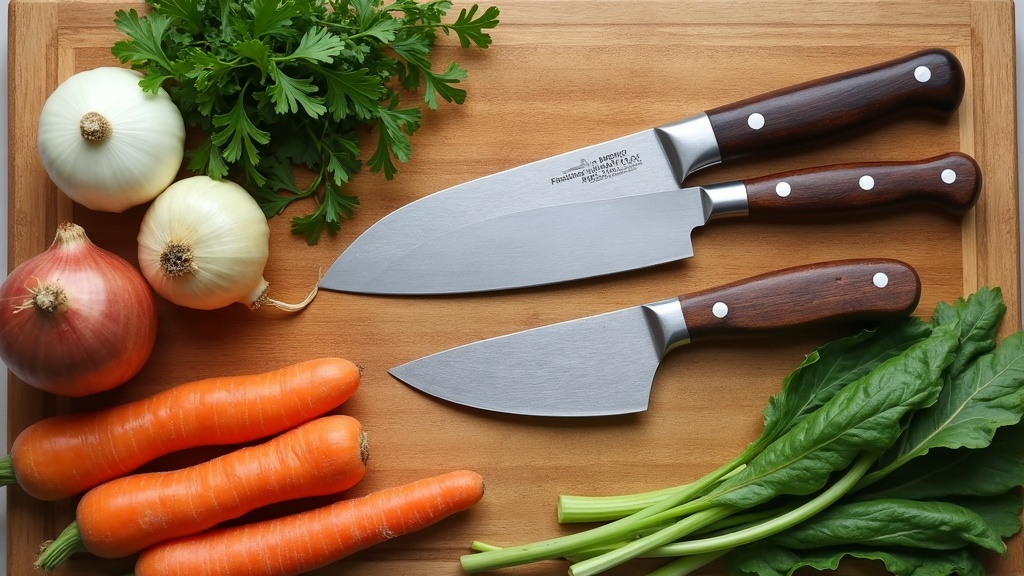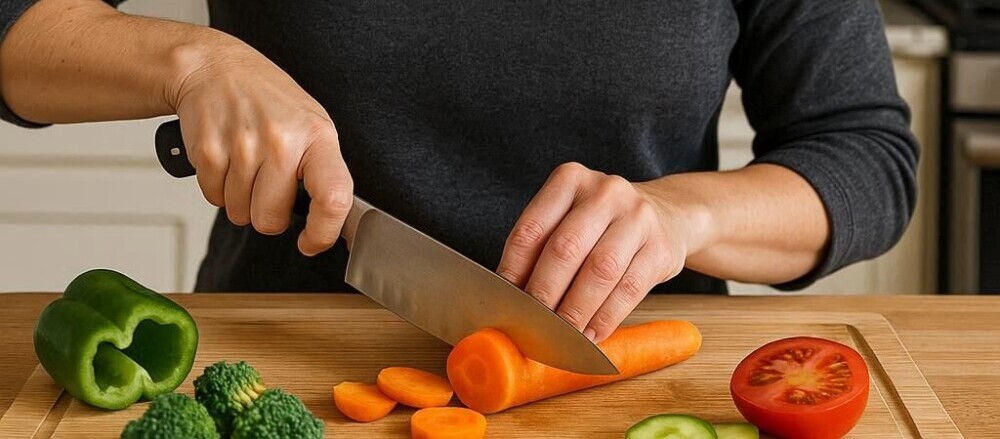 Feel like chopping takes longer than cooking? You’re not alone. The secret isn’t more knives; it’s better technique.
Feel like chopping takes longer than cooking? You’re not alone. The secret isn’t more knives; it’s better technique.
With just a few skills, homemade dinners, lunches, and snacks get a whole lot faster, easier, and safer. Ready to chop like a chef without losing a finger or your mind? Here’s my tried-and-true guide to mastering knife skills from scratch.
Step 1: Pick the Right Knives (You Don’t Need a Full Set)
Here’s some good news: you only need three knives for nearly every kitchen job. Skip the 10-piece sets and stick with these:
- Serrated Knife: Awesome for bread and anything squishy like tomatoes or bagels.
- Chef’s Knife: The true workhorse for most jobs: chopping, slicing, dicing. You’ll reach for this one over and over. Check this post to help find the correct one for you.
- Paring Knife: Handles the small stuff, such as peeling strawberries, trimming fat, or slicing a garlic clove.
Keep your knives sharp. It’s way safer and saves you lots of energy while you’re prepping.
Step 2: How to Hold Your Knife Like a Pro
If your knife feels awkward or you don’t feel in control, it’s probably about the grip. I’ve tried a few different holds, and these two work best:
- Handshake Grip: Grab the handle like you’re shaking hands with a friend. It’s solid and steady for big jobs but can feel a bit clunky on detail work.
- Pinch Grip: Pinch the blade just in front of the handle with your thumb and pointer finger, then wrap your other three fingers around the handle. This is the go-to move for most chefs (me too) because it gives you more precision and control.
If you haven’t tried the pinch grip, it might feel strange at first, but it becomes super natural with a bit of use. Suddenly, chopping feels a whole lot easier.
Step 3: Keep Your Food Steady (So It Doesn’t Run Away)
Ever try to chop a rolling carrot or wobbly onion? That’s a great way to slice your dinner and your finger. Here’s what I do for extra safety and speed:
- If your food has a round side, like potatoes or cucumbers, slice a thin piece off to create a flat base. Place the flat side down, and you’re good to go.
- Keep the cutting board dry. Wipe off water or juice so your food doesn’t skate around.
- For leafy greens, gather them in a bunch (or roll them up for certain cuts), then chop away with confidence.
The more stable your food is, the faster and more accurately you can chop. No acrobatics required.
Step 4: Protect Your Fingers With “The Claw”

This technique has saved my fingertips more times than I can count. Curl your knuckles inward and tuck your fingertips under, resting the side of the knife blade against your knuckles as you chop. The tips stay safely away from the sharp edge, and your hand guides the blade for even slices.
With a bit of practice, “the claw” turns chopping from a stressful event into a smooth part of your routine. Over time, you won’t even have to think about it—your fingers will naturally curl for safety.
Step 5: Core Cutting Techniques (Plus a Few Fancy Cuts)
Rock Chop
Line up whatever you’re cutting. Place the tip of the knife on the board so it stays in contact, and rock the blade down from tip to heel for smooth, even slices. This is the common move for onions, carrots, celery, and herbs.
Bias (Diagonal) Cut
Turn your food at a 45-degree angle to the knife, then slice. Potato wedges, green onions, or stir-fry veggies look pretty and cook evenly using this cut.
Mincing
Bunch up small foods such as garlic, ginger, or herbs, then use a rocking motion keeping the tip on the board and move the heel up and down quickly. Sometimes I pile up chopped pieces and go back over them if I need it super fine.
Dicing
- Slice into planks (thin vertical slices).
- Stack your planks and slice into strips.
- Turn the strips sideways and cut across them for cubes.
This technique works for onions, peppers, carrots—anything you want in even squares. The trick is to keep your pieces the same size for even cooking.
Wedges
Cut the item in half, then halve those halves, and repeat as needed. If you want eight fairly even wedges, use this simple approach. This is great for apples, potatoes, and citrus fruits.
Chiffonade (For Leafy Greens)
Stack the leaves, such as basil or spinach, roll them up tightly, then slice into thin ribbons. This trick makes salads, garnishes, or stir-fries look extra special with almost no extra effort.
Step 6: Prep Tips That Make Chopping Faster
- Cut everything the same size so it cooks evenly. Uniformity not only looks good but also helps with taste and texture.
- Work in batches. It’s easier to chop a few carrots at once than just one.
- Use a bench scraper or the dull side of your knife to move chopped ingredients. Never run the sharp edge along the board, or you’ll quickly dull your knife.
- Lay out all your ingredients before you begin. Being organized pays off and cuts down on prep time.
- Try different cuts to find which feels most natural to you; comfort with technique leads to better speed and accuracy.
Chopping gets faster the more you do it. I used to take ages, but now, with these habits, prep is kind of a breeze and a whole lot more fun.
Step 7: Staying Safe and Practicing Good Habits
- Keep your knives sharp. They cut easily and are far less likely to slip.
- Use a large, steady cutting board. Slip a damp towel underneath if it’s moving around to add stability.
- Clean as you go so nothing piles up and crowds your workspace.
- Always use dry hands and dry food. This helps keep everything under control, limiting the chance of the knife slipping.
These little habits make each cooking session smoother and keep your fingers out of harm’s way. With steady practice, safety becomes second nature.
Common Knife Skill Questions Answered
Why does my knife keep sticking to what I cut?
This usually happens with starchy foods like potatoes. Wipe the knife with a damp towel between cuts or use a little nonstick spray if you like.
What if my knife keeps slipping?
- Sharpen it. Dull blades are notorious for slipping.
- Dry what you’re cutting and your hands to keep everything steady.
- Double-check for a secure grip and a steady cutting surface. If necessary, slow down and refocus your hand positions.
How do I get faster at chopping?
Repetition is key. Start slow to build muscle memory and don’t worry about speed. Clean technique translates into speed over time. Watch professionals on YouTube, or simply repeat basic tasks like chopping onions, carrots, or herbs every week. Over time, the moves become second nature, and your speed increases without effort.
Next Steps: Ready to Chop Like a Chef?
Mastering knife skills isn’t about fancy gadgets or expensive tools. It’s about practicing a few simple techniques every time you walk into the kitchen, and being kind to your fingers. Start with the basics, focus on safety and form, and soon, prep time melts away—almost as fast as an onion brings tears to your eyes.
Your Chopping Action Plan:
- Pick one key skill to practice each time you prep (maybe the pinch grip or “the claw”).
- Use the right knife for the job—chef’s, paring, or serrated.
- Prep your workstation and take it slow. You’ll naturally get quicker the more you do it.
Have a question about a specific ingredient or cutting trick? Drop it in the comments; I’m happy to help!
And if you want to truly take your cooking up a notch, continue to check out new recipes or dig into advanced techniques. Mastering knife skills is just the start; soon you’ll be prepping like a pro and wowing your friends or family at the dinner table. Every meal is a chance to improve, and there’s always something new to stumble upon in the kitchen. Happy chopping!
